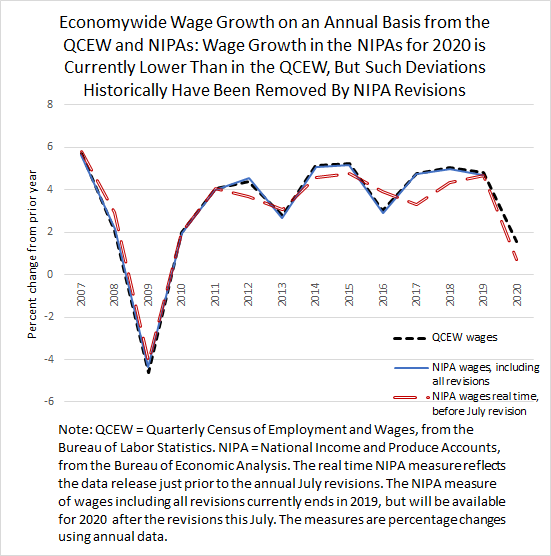Posted on June 4, 2021
This week the Bureau of Labor Statistics released the full report on how much wages and salaries were in 2020Q4, and hence for all of 2020, as measured by the Quarterly Census of Employment and Wages (QCEW). The QCEW are important administrative data provided by nearly all employers in order for the federal and state governments to administer the unemployment insurance program. Administrative data are generally much better than data from surveys. The QCEW measures economywide wages and salaries growing by 1.5 percent in 2020, which is about 0.8 percentage points higher than the 0.7 percent growth currently measured in the National Income and Product Accounts (see chart below). Historically, wage growth in the NIPAs has been revised in the annual July revisions to line up nearly exactly with that shown in the QCEW, which is the main underlying data source for the NIPAs. (On the chart, the lines for wage growth in the QCEW and NIPA wages including all revisions are virtually on top of each other. The real-time NIPA data, available at the time just before the subsequent revisions, can differ from the subsequently-revised data.) Hence, we expect that in late July NIPA wages will be revised up by that 0.8 percentage points to line up with the QCEW. Caveats include that the NIPAs add estimates of some components that are not included in the QCEW, such as from the small share of workers not covered by unemployment insurance. Those NIPA adjustments are relatively small but in the 2020 pandemic year normal relationships may not apply.
In an upcoming post, we plan to use this expectation for a NIPA revision to develop a new projection for the 2020 national average wage index (AWI) for Social Security, an important measure for various purposes. We have posted on the AWI previously. We expect that given the latest wage data, it is becoming less and less likely that we will see a drop in the AWI for 2020 after the Social Security Administration tabulates the relevant data and releases the measure probably in October.
